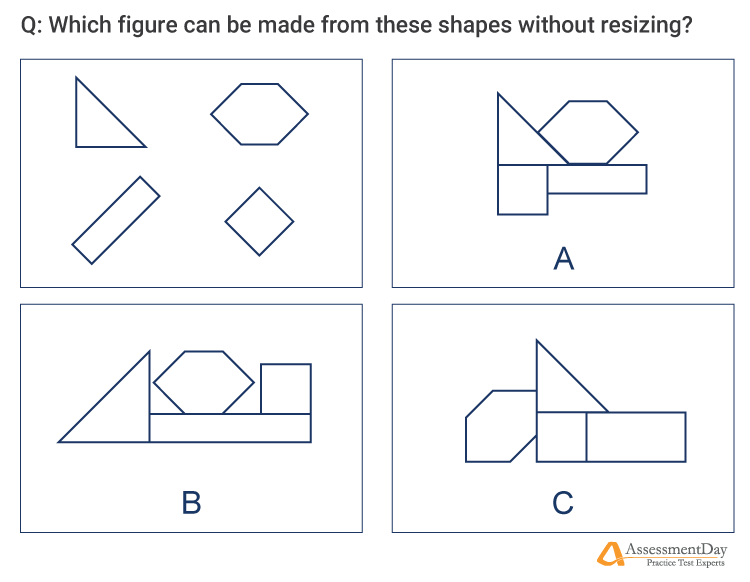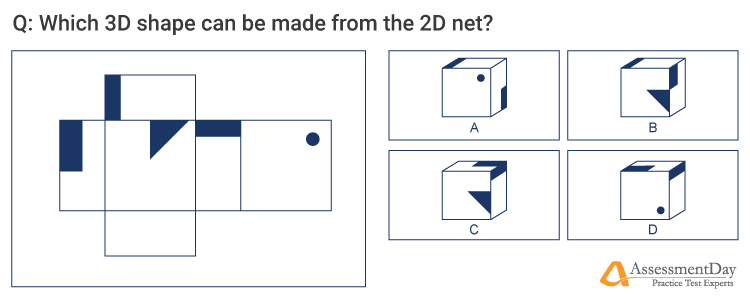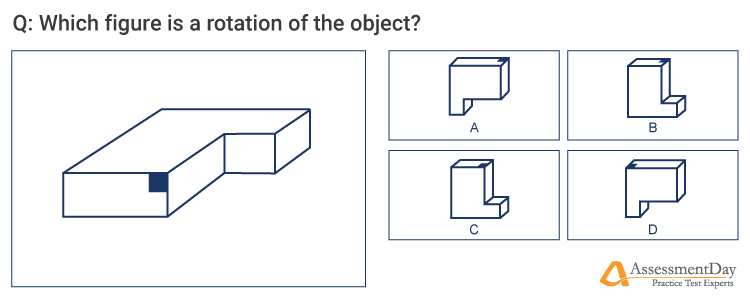Spatial Reasoning Tests
Practice tests and answers, along with expert advice and tips to help you pass your spatial awareness tests.


Updated:
Have you been asked to take a spatial reasoning test and you're not sure what to expect? Need to ace the test to get to the next assessment stage?
Our practice tests are created by the same psychologists who design tests for the likes of SHL, Kenexa, and Saville Assessment. So our test platform and example questions will give you a good feel for the spatial reasoning tests employers use. Read on and soon you'll have a complete understanding of what spatial reasoning tests are and be confident taking that test.
Page contents:
Jump to:Looking to hire?
We recommend Test Partnership for companies seeking reliable hiring tests.

What is a spatial reasoning test?
Spatial reasoning tests, also known as spatial awareness/ability, are used to assess a candidate's capacity to manipulate 2D and 3D objects, spot patterns between shapes, and to visualise movements and change in those shapes. This could include identifying which answer option is a rotation of a given 2D image. Spatial awareness is something we exhibit everyday as we interpret objects and shapes in our daily lives. These tests can be difficult to explain and often best understood through examples which we will cover later.
There are several different types of spatial reasoning questions that you will have to face within a test, so it's important that you are comfortable with all the different types of questions.
These tests are more common for technical and engineering applicants, and will only be included in your application process if the role requires a person with good spatial reasoning ability. So if you've been tasked with taking a spatial awareness test then it's likely possessing these skills will be an important part of being successful in your chosen career.
What to expect from your spatial reasoning test
If you are considering a career in architecture, engineering, industrial design, 3D game design (and others) then you will require high spatial intelligence. This will make it an extremely popular aptitude test for employers to predict your future job performance. It's vital that you can develop and demonstrate these skills effectively, so a full understanding of what to expect from the tests and sufficient practice will be invaluable.
Survey results
In 2020, we surveyed job applicants to find out more about their spatial reasoning tests. We asked them what tasks they faced in their spatial test, to get a better understanding of what are the most likely operations you will be tasked with. 85% of candidate's tests included 2D to 3D operations.

These tests will be most often timed and of a multiple-choice nature. You will be given instructions before your test starts so pay close attention to the time allowance and all other key information given to you.
So let's talk about some of the common question types you may face:
Organising 2D shapes
In this type of question you will have to demonstrate your ability to assemble and dissemble 2D shapes. You will be presented with a few 2D shapes and be asked to select which of the answer options represents the shape that could be formed by combining all the different shapes together. These questions will assess your ability to understand relative sizes of shapes and your ability to orientate/manipulate them. Conversely, the question may ask you the opposite: to identify which group of shapes could fit together to create a displayed shape.
The sides of the shapes may have letters (x,y,z etc.) on so that you can distinguish the different lengths and how they match up the corresponding sides. It may be that the shapes will be true to size and you'll be asked to pick the correct option without resizing any individual shapes.
Let's try an example before moving onto the next question type...
(The answer will be below so don't scroll too far if you want to try to answer it yourself)

-----------------
The correct answer is: A
Transforming 2D nets to 3D shapes
These may be the hardest of the question types due to the level of spatial intelligence required to mentally perform the task. I'm sure most of us were tasked with cutting out 2D nets of cubes and other 3D shapes when we were at school, and having to glue them into their 3D form. These questions will require you to mentally construct those 3D shapes (without the assistance of paper and scissors!).
You will be presented with a 2D net of (more often than not) a cube or cuboid and must identify which of the answer options can be created by that 2D net. However, what makes these challenging are that each side of the shape will have a certain pattern or colour. This requires you to mentally work out how each side will look once it's been folded together and rotated - be sure to keep note of how patterns may change once turned 3D and when rotating.
P.S. If you didn't know a net is just the 2D representation of a 3D shape. So if you unfolded the 3D shape along it's edges, the shape it would form once it was flat (2D).
Right, let's see if we can answer this one correctly...

-----------------
The correct answer is: C
Rotations and reflections
These questions are trying to determine your ability to mentally rotate shapes. You could be asked to do this with 2D or 3D shapes. This is much easier with 2D shapes as there are just two dimensions to deal with. You may be familiar with the 2D versions as they are common place in standard non-verbal reasoning tests, ones that you may have faced during school.
The ability to mentally rotate 3D shapes is much harder and will require strong understanding of the properties of an object and also memory. You will be asked which of the options is a rotation of the shape in the question. The answer options will be the same 3D form but each answer option will possess a distinguishing marker(s) which will result in them being incorrect and leaving only one possibly correct answer. These distinguishing marks may come in the form of a coloured in shape on one side of the object, a dot, or different coloured/shaded sides.
Now we've understood this new question format, let's take on another practice question:
Right, let's see if we can answer this one correctly...

-----------------
The correct answer is: B
Those are the common types of questions you will face, hopefully you managed to answer a couple of our examples correctly.
Free practice spatial reasoning test
Free Spatial Reasoning Test
FreeThis free shortened logical reasoning test contains 12 questions and has a time limit of 8 minutes.
Spatial Reasoning Test 1
Premium- 22 questions
- 15 mins
Spatial Reasoning Test 2
PremiumSpatial Reasoning Test 3
PremiumSpatial Reasoning Test 4
PremiumHow to prepare for spatial reasoning tests
As you can see, there's a variety of skills required to be able to confidently answer spatial reasoning questions - they're not easy!
If you felt unsure about any of these question types, it's essential that you practise them until they are no longer a struggle. It's our best advice and the advice that everyone else will give you. Your assessment will be timed so you don't want to be spending too much time on any question or becoming stressed due to the difficulty of the test.
We have timed practice tests which will simulate the real experience which you can find in our spatial reasoning practice pack - there's really no better way to practice.
Start practising quality tests with a free account
Practice makes perfect
- Learn from detailed solutions
- Track your progress

Here's a few last bits of advice from us:
- 1. Understand the different tests - Read back through the tests we've mentioned and practice the different questions with our practice tests - it's essential you're familiar and comfortable with all possible questions. You'll be improving a skill that is valuable for your future career, so be sure to take it seriously.
- 2. Research your test - Look into what test publisher that the hiring company use. Publishers may have differed with how they have created their tests, so learn as much about them as you can. Test characteristics will be mentioned in the instructions you are given prior so take note of that and don't just skip through.
- 3. Check time limits before you start - within the instructions it should mention the time you have allowed to try and complete the test. It will more than likely be as an overall X minutes for X questions, not per question. If this is the case, work out how much time you should allow yourself for each question.
It's unlikely that you'll need to just take a spatial reasoning test as these are often coupled with numerical reasoning, verbal reasoning, inductive reasoning or other tests types. We have information on all these test types, with free practice questions and extensive practice packs that are sure to boost your test performance.